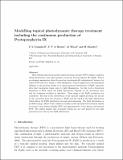Modelling topical photodynamic therapy treatment including the continuous production of Protoporphyrin IX
Abstract
Most existing theoretical models of photodynamic therapy (PDT) assume a uniform initial distribution of the photosensitive molecule, Protoporphyrin IX (PpIX). This is an adequate assumption when the prodrug is systematically administered; however for topical PDT this is no longer a valid assumption. Topical application and subsequent diffusion of the prodrug results in an inhomogeneous distribution of PpIX, especially after short incubation times, prior to light illumination. In this work a theoretical simulation of PDT where the PpIX distribution depends on the incubation time and the treatment modality is described. Three steps of the PpIX production are considered. The first is the distribution of the topically applied prodrug, the second in the conversion from the prodrug to PpIX and the third is the light distribution which affects the PpIX distribution through photobleaching. The light distribution is modelled using a Monte Carlo radiation transfer model and indicates treatment depths of around 2 mm during daylight PDT and approximately 3 mm during conventional PDT. The results suggest that treatment depths are not only limited by the light penetration but also by the PpIX distribution
Citation
Campbell , C L , Brown , C T A , Wood , K & Moseley , H 2016 , ' Modelling topical photodynamic therapy treatment including the continuous production of Protoporphyrin IX ' , Physics in Medicine and Biology , vol. 61 , no. 21 , pp. 7507-7521 . https://doi.org/10.1088/0031-9155/61/21/7507
Publication
Physics in Medicine and Biology
Status
Peer reviewed
ISSN
0031-9155Type
Journal article
Description
C L Campbell acknowledges financial support from an UK EPSRC PhD studentship (EP/K503162/1) and the Alfred Stewart Trust.Collections
Items in the St Andrews Research Repository are protected by copyright, with all rights reserved, unless otherwise indicated.

